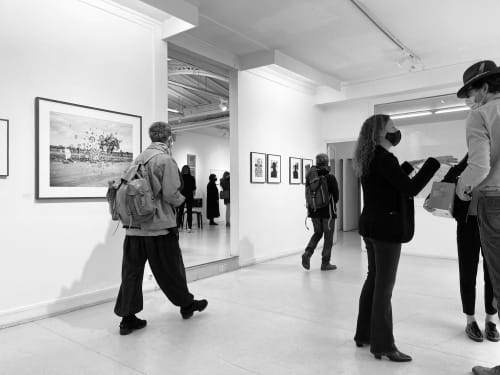Opening (upon invitation only):
25 may / 14:00 - 21:00
VIP opening hours:
26, 27, 28, 29 & 30 may / 11:00 - 13:00
Public opening hours:
26, 27, 28 & 29 may / 13:00 - 20:00
30 may / 13:00 - 18:00
French text below
The publication in 1899 of The Native Tribes of Central Australia caused a sensation in Europe. The book’s authors, telegraph-station master Francis J. Gillen and ethnologist W. Baldwin Spencer, had written in depth about the customs and traditions of the Aboriginal groups living near Alice Springs and also illustrated their texts with 119 photographs, many of which captured rituals and ceremonies. While the subject, quality and quantity of the images set a new standard for anthropological photography, the authors were largely oblivious to the impact they would have on the lives of the Aboriginals. The pictures revealed the gap in knowledge between the authors, whose goal was showing the exotic natives “in their natural state”, and the subjects, who were completely unaware of the new medium and how it could invade their privacy or reveal their secrets to a wider audience. Unwittingly or not, the authors also infringed upon Aboriginal cultural protocols by showing sacred sites and the dead.
Attitudes have changed since Gillen and Baldwin Spencer first ventured in the Central Desert with a camera and institutions have taken extensive measures to ensure that cultural sensitivity is respected. Today, photography within Aboriginal communities is limited and historical images are often “restricted”. Over the past four years, Patrick Waterhouse has taken photographs in the Yeundumu and Nyirrpi Aboriginal communities, and in the surrounding Warlpiri country. After making prints, he returned to Central Australia to work with local artists and other members of those same communities at the Warlukurlangu Art Centre, so they could restrict and amend his photographs through the process of painting.
Waterhouse’s work has been exhibited internationally in institutions including FotoMuseum, Antwerpen (2019); Albuquerque Museum, Albuquerque (2018); Kunsthal, Rotterdam (2017); The Guggenheim Museum, Bilbao (2016); National Gallery of Art, Washington D.C (2015); The Photographers’ Gallery, London (2015); The National Galleries of Scotland, Edinburgh (2014); Le Bal, Paris (2014); Biennale de Lubumbashi, DR Congo (2013); The International Center of Photography Triennial, New York (2013); Liverpool Biennial, Liverpool (2012); The Museum für Gestaltung, Zürich (2011) and South African National Gallery, Cape Town (2010). His work is held in major public and private collections including Solomon R Guggenheim Museum, New York; San Francisco Museum of Modern Art, San Francisco; Centre Pompidou, Paris; The National Gallery of Art, Washington D.C and The Walther Collection, Neu-Ulm, Germany. Awards include the Discovery Award at Rencontres de la Photographie, Arles in 2011 and the Deutsche Borse Photography Prize in 2015 for Ponte City (with Mikhael Subotzky).
FRENCH
A PPR OC HE @ Galerie Papillon / 13 rue Chapon / Paris 3ème
Vernissage (sur invitation):
25 mai / 14:00 - 21:00
VIP (sur invitation):
26, 27, 28, 29 & 30 mai / 11:00 - 13:00
Ouverture au public (entrée libre, sur réservation):
26, 27, 28 & 29 mai / 13:00 - 20:00
30 mai / 13:00 - 18:00
En 1899, la publication de The Native Tribes of Central Australia a fait sensation en Europe. Francis J. Gillen et W. Baldwin Spencer avaient illustré leur ouvrage sur les groupes d’aborigènes d’Alice Springs de 119 photographies. Si celles-ci ont imposé un nouveau modèle pour l’anthropologie, les auteurs n’avaient pas mesuré leur impact sur les aborigènes. Transgressant certaines de leurs croyances en montrant des morts ou des sites sacrés, elles trahissaient le fossé culturel entre les auteurs, qui avaient voulu montrer « ces lointains sauvages à leur état naturel », et les aborigènes, qui n’avaient pas mesuré le potentiel intrusif du procédé.
Les attitudes ont évolué : les institutions sont garantes de sensibilité culturelle, et les photographies des communautés aborigènes sont restreintes, même, souvent, si elles sont anciennes. Patrick Waterhouse a ainsi vécu pendant plus de cinq ans avec les populations Warlpiri de Yuendumu et de Nyirripi. Après un aller-retour en Angleterre pour les tirages, il a invité les artistes locaux à restreindre ses photographies grâce à la peinture à points traditionnelle, rendant ainsi aux aborigènes le contrôle de leur propre représentation.
Patrick Waterhouse (Angleterre, 1981) s’intéresse à l’histoire et à la mémoire. Ses photographies ont été exposées, entre autres, au FotoMuseum d’Anvers, au musée Guggenheim de Bilbao et à la National Gallery of Art de Washington. Elles ont également intégré des collections comme celles du musée Guggenheim de New York, du SFMOMA (San Francisco) et du Centre Pompidou (Paris). Entre autres récompenses, il a reçu le Prix Découverte Louis Roederer des Rencontres d’Arles et le prix Deutsche Börse avec Mikhael Subotzky.

